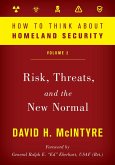Volume 1:The Imperfect Intersection of National Security and Public Safetyexplains homeland security as a struggle to meet new national security threats with traditional public safety practitioners. It offers a new solution that reaches beyond training and equipment to change practitioner culture through education. This first volume represents a major new contribution to the literature by recognizing that homeland security is not based on theories of nuclear response or countering terrorism, but on making bureaucracy work. The next evolution in improving homeland security is to analyze and evaluate various theories of bureaucratic change against the national-level catastrophic threats we are most likely to face. This synthesis provides the bridge between volume 1 (understanding homeland security) and the next in the series (understanding the risk and threats to domestic security). All four volumes could be used in an introductory course at the graduate or undergraduate level. Volumes 2 and 3 are most likely to be adopted in a risk management (RM) course which generally focus on threats, vulnerabilities, and consequences, while volume 4 will get picked up in courses on emergency management (EM).
Bitte wählen Sie Ihr Anliegen aus.
Rechnungen
Retourenschein anfordern
Bestellstatus
Storno









